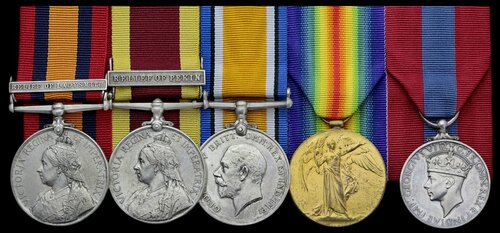
Auction: 21003 - Orders, Decorations and Medals
Lot: 302
(x) Five: Able Seaman A. B. Winnett, Royal Navy, who served with ashore as a Bluejacket in South Africa and China, who latterly served at the Battle of Jutland
Queen's South Africa 1899-1902, 1 clasp, Relief of Ladysmith (A. S. Winnett, Ord: H.M.S. Terrible); China 1900, 1 clasp, Relief of Peking (A.S. Winnett, A.B., H.M.S. Terrible.); British War and Victory Medals (190101 A.S. Winnett. A.B. R.N.); Imperial Service Medal (Albert Sydney Winnett), contact marks and edge bruising, very fine (5)
Albert Sydney Winnett was born at Chelsea, London on 1 February 1881, son of John and Diana Winnett of 6 Davis Place, he was baptised at St. John's Church, World's End on 17 April. The family moved in with Winnett's grandfather, also called John, by 1891 at 3 South End, Chelsea. Prior to enlistment he worked as a telephone wirer, attesting with the Royal Navy on 6 August 1896 with the rank of Boy Class II. Posted for training aboard H.M.S. Ganges on 11 August 1896 he was promoted while here to Boy Class I on 16 May 1897 before transferring for further training aboard Impregnable on 11 June 1897. His first posting was to the Shore Establishment H.M.S. Pembroke I from 14 December 1897-23 March 1898. However after this Winnett was at last given a post at sea aboard H.M.S. Terrible, a Powerful-class protected cruiser. Serving on her from 24 March he achieved his majority while aboard becoming first an Ordinary Seaman on 17 February 1899. That same year the Terrible took part in the Second Boer War, arriving on station in South Africa on 14 October 1899. The Ship's Captain, Percy Scott, seeing no threat from the sea decided to make use of his powerful naval guns on land where the Boer's 'Long Tom's' too often had the edge over British guns. With the Naval Brigade of H.M.S. Powerful going on ahead to aid in the Defence of Ladysmith while Terrbile's Brigade took part in it's relief. The Naval Guns went into action at Colenso on 15 December 1899 and later at Spion Kop and Vaal Krantz. When the British eventually broke the Boer defensive lines over the Tugela River it was the heavy guns of Terrible's Naval Brigade which covered their advance. With the relief of Ladysmith the crew of Terrible returned to their vessel, leaving Durban for China to see service in the Boxer Rebellion on 27 March 1900. En-route Winnett was promoted Able Seaman on 22 July 1900.
With the vessels arrival into Hong Kong on 8 May 1900 the 12 pounder naval guns were again mounted onto field carriages for use by a Naval Brigade. The Terrible took three companies of the Royal Welsh Fusiliers to Taku, arriving on 21 June. From there they moved on to Tientsin, defeating the Chinese army defending the city on 9 July 1900 and lifted the Siege of Peking on 15 August. With this victory the crew of the Terrible returned to their ship on 7 September. After a typhoon struck Hong Kong on 17 December the Terrible remained on hand to help, raising a capsized dredger in the Canton River and providing relief to those affected by the disaster. The vessel finally left for Britain in July 1902, arriving on 19 September they were treated to a public dinner in Portsmouth. Winnet's inter-war service was largely confined to shore establishments such as H.M.S. Pembroke, starting on 25 October 1902 and Depot ships such as H.M.S. Northumberland, starting 15 December 1903. He purchased his discharge on 22 March 1904, joining the Royal Fleet Reserve at Chatham the next day.
Life after the navy does not seem to have suited Winnet however and he re-enrolled on 23 March 1909 with his former rank of Able Seaman. With the outbreak of the Great war he was serving aboard H.M.S. Prince George a post he held from 13 July-16 August 1914. Serving variously aboard H.M.S. Albion, Vivid and Victory III he soon joined the M-class destroyer H.M.S. Moorsom. It was aboard this ship that Winnett would face the first naval combat of his eventful career at Jutland. They sailed with the Grand Fleet, taking station with 13th Flotilla ahead of H.M.S. Lion on 31 May. The order to launch a torpedo attack came at 16:10 on 1 June with Moorsom taking its place in the first wave. Unfortunately the attack was intercepted by German destroyers and their torpedoes went unfired. Driving off the German warships the flotilla was ordered to launch a torpedo attack against the van of the High Seas Fleet. This time they were successful and Moorsom launched two torpedoes, receiving a hit aft in exchange though it proved not to be serious. Launching another two torpedoes Moorsom joined by Lydiard disengaged to the side of 5th Battle Squadron and took no further part in the action. They returned to base at 20:15 due to a lack of fuel, their oil tanks after having suffered some damage, possibly from the hit they took during their torpedo run. Following Jutland Winnett remained on Moorsom for some time, later being transferred to H.M.S. Skate an R-class destroyer which was completed in February 1917. It was torpedoed by SM UC-69 on 12 February in the North Sea and on 26 March 1917 Winnett was transferred to Pembroke I. Returning to Skate after her repairs he served aboard from 3 July 1917-15 February 1918.
Winnett worked as a Cable joiner after the war, being awarded the Imperial Service Medal on 21 June 1946 (London Gazette 18 June 1946, refers). He died at Haringey in June 1971; sold together with copied medal rolls, service records and London Gazette entry.
Subject to 5% tax on Hammer Price in addition to 20% VAT on Buyer’s Premium.
Sold for
£580
Starting price
£320
Sale 21003 Notices
Not entitled to clasps upon the first two Medals and further entitled to 1914-15 Star.




